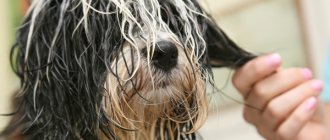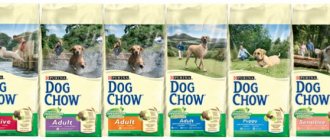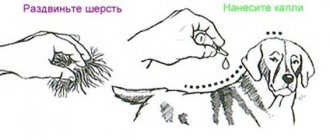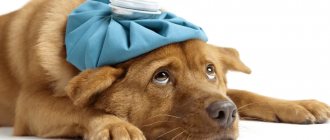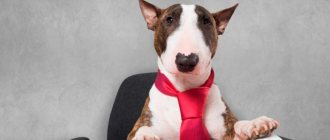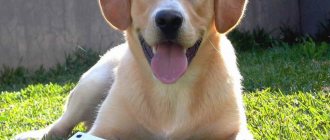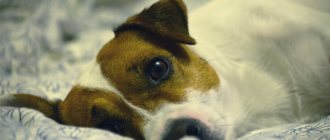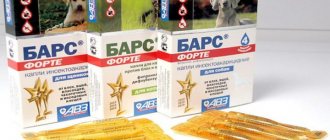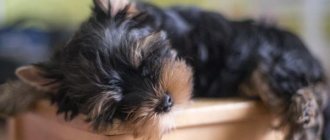If you want your Yorkshire Terrier, Biewer Yorkie or Biro to look great, its coat needs to be properly cared for.
The pet needs to be washed regularly. Don’t listen to “advisers” who claim that your dog should be washed as little as possible; this is true for many breeds, but not for Yorkies. If your Yorkie has long hair, then washing should be done once a week; if the baby has short hair, then you can bathe less often, once every two to three weeks, as it gets dirty.
Yorkie wool
Good heredity means beautiful coat! The skin and coat of a Yorkshire Terrier should be the object of constant attention from the owner, because they not only reflect our aesthetic perception of the dog, but also indicate its health. Length, density, color, shine primarily depend on hereditary factors. All immediate ancestors should have a coat of correct structure, which reaches floor length at 15-20 months. That is, with the height of an adult Yorkie being 20-26 cm at the withers, the growth rate of the coat should be at least 15-20 mm per month. It should also be taken into account that the sun's rays have an adverse effect on wool. Salty sea water negatively affects the quality of wool. Too dry indoor air contributes to dry skin and brittle hair. You should not allow your Yorkie to lie near the battery. It must be remembered that the rate of fur growth in a young dog is much greater than in an adult dog. Often the growth rate of hair on the body is much greater than on the head. Split wool does not grow well, so split ends must be trimmed. During certain periods of a Yorkie's life, the rate of fur growth changes. It slows down during the puppy's teeth change, during the bitch's heat and pregnancy, and also during the feeding period of the puppies. Illness or stress can also cause slow fur growth. Wool and skin are a mirror of health! The skin provides protection for the body from the external environment, retains the necessary amount of moisture, fats, mineral salts and vitamins, protects the body from the penetration of foreign microorganisms and, together with the corresponding glands, produces an individual smell, which is necessary at the time of communication with one’s own kind. Insufficient or unbalanced nutrition can worsen the condition of the coat. So, if there is a lack of fat in the dog’s diet, peeling of the skin is observed, localized first in the abdomen, then on the tail and, finally, on the back. The appearance of rashes, ulcers, and pimples is often observed. Mineral salts and trace elements have a specific effect on the skin and coat. Lack of sodium and chlorine causes dry skin and hair loss, lack of copper leads to loss of pigmentation; A lack of zinc can be judged by the appearance of plaques, crusts at the roots of the hair, in the corners of the mouth, around the eyes, ears, etc. An unbalanced intake of iodine compounds deteriorates the coat, making it brittle and short. Problems like these typically arise from feeding dogs leftovers from family meals. This is absolutely NOT possible to do!!! Unhealthy skin, crusts around the eyes, near the nose and on the tail, redness, flaking, itching, inflammation and, as a result, hair loss are very often associated with a lack of various vitamins. With a biotin deficiency, dandruff, itching, and inflammation of the sebaceous glands appear. The coat becomes dry, pigment weakens and baldness may begin. Don't be fooled into thinking that taking individual vitamins and mineral supplements will do a miracle. It would be too easy. Hypervitaminosis, as well as hypovitaminosis, can lead to serious consequences. If there is the slightest problem, you should contact a veterinarian.
Disadvantages in the color of the Yorkie
Disadvantages of the Yorkshire Terrier color include excessive blackening or, on the contrary, too short a saddle length, leading to an almost red color. This is due to the fact that black saddle color can vary greatly. In some cases, the dog will be almost black with traces of red color on the legs, under the tail and faint spots above the eyes. In others, the saddle cloth is so small that the dog looks almost red with a dark stripe on the back. Sometimes the black saddle color can look almost tan. Such a wide range of variations in black-and-white color is associated with the action of special modifier genes. These are genes that can modify the action of the main gene, but manifest themselves only in the presence of the main one (in this case, the pair of genes sa sa aa).
It should be noted that the question of the presence of separate genes responsible for the development of tan and saddle-back colors is controversial. For example, one of the main luminaries of dog color genetics, K. Little, who worked in the middle of the last century, considered the saddle color as a result of the combined action of tan genes and modifier genes. Robinson, Willis and a number of other later authors unequivocally stated the presence of specific alleles for the saddle color. At the moment, a specific gene for black-and-white color has not yet been identified using precise molecular genetic methods, but researchers do not deny its presence. Moreover, it has been suggested that there may be several alleles for such an effect (SMSchmutz, 2005).
Common color faults in the Yorkshire Terrier are light or even whitish tan marks . They are determined by a number of genetic factors that affect the distribution of red pigment.
Should you cut your dog's hair for the summer?
Some owners think that the easiest way to solve the problem of mats in the warm season is to cut the dog's hair. But this can be dangerous.
Wool protects against overheating in hot weather and helps to withstand adverse weather conditions. Dogs with short hair suffer from insect bites. They are susceptible to mechanical damage to the skin. Sometimes clipping causes a disorder called follicular arrest. Hair growth slows down greatly, but the original appearance is restored within many months. Scientists cannot yet explain why this happens.
Haircuts can be hazardous to health
But you can’t do without a haircut in such cases:
- most of the pet’s body is covered with pellets;
- felted wool hurts;
- there is a suspicion of parasite infection;
- Dermatological diseases have been identified - for example, eczema.
In order for a dog to have a beautiful coat and good health, it needs careful care. Preventive shearing does not solve the problem of tangles. Therefore, before taking a long-haired animal into your home, you should think: do you have the time, energy and patience to take care of a new family member?
How to teach a dog to brush?
Brushing is an integral part of caring for your dog. You can completely avoid this responsibility only if you have a “bald” pet. Therefore, the issue of accustoming the dog to this procedure is very important. Practice shows that with the right approach to raising a puppy, problems with combing almost never arise. The ideal age for accustoming to combing is considered to be from one to three months.
While the pet gets used to the procedure, it is necessary to handle its fur and skin very delicately. Any pain can be remembered for a long time by the puppy and he will have the wrong idea about combing. Adult animals also need to be trained gradually and carefully. An excellent motivation for your pet to endure the procedure is subsequent feeding with tasty treats.
Every dog should be able to calmly tolerate grooming and brushing. To ensure that such procedures do not become chronic stress for your pet, it is necessary to pay special attention to the training of brushing.
A little about caring for a Yorkie puppy's coat:
The puppy is washed every 10 days. I use a mild shampoo. Definitely with air conditioning. I never use two-in-one products and I don’t recommend it! If the puppy does not tolerate washing well, wash it more often, so he will get used to it faster. In order for the puppy to get used to the combing procedure, brush it every day, and sometimes several times a day. Be sure to use a combing spray. As soon as the baby gets used to the comb, increase the intervals between combing. First every other day, then after 2 days, and then they look at the condition of the coat. Do not oil the puppy's fur; it is not advisable to use a spray that contains oil and alcohol. At the age of 5 months (they look at the condition of the coat, the number of tangles increases, the coat is dry to the touch) they will begin to make an oil mask an hour and a half before washing. I use different oils or a mixture of oils (linseed, jojoba, almond, coconut, burdock, etc.) And also after combing the coat, you can apply oil or balm that does not need to be washed off. First, the oil is poured into a low flat container and diluted with water in a 1:1 ratio. What oils should I use? The most suitable oils are wheat germ, grape seed, mink, burdock, peach, coconut... Oil consumption per dog at a time should be no more than half a teaspoon. Heavily oiled wool looks greasy and sticky and quickly absorbs dust and dirt. Using a soft brush, apply oil or balm evenly to combed strands, but in no case to the skin, in the following places: under the eyes, on the forehead, on the back of the nose, on the sides of the muzzle and head, on the neck, then on the body, starting from the back , last but not least, on the paws. At the age of 6-8 months and older. Wash the dog once a week, regardless of whether the dog is washed with oil or just with conditioner. Wool without curlers with oil applied gets dirty very quickly; without oil it begins to dry out, even if you use a very good conditioner. Dirty wool does not grow well. For a male dog, if he is not wearing a diaper, the hair in the lower back area is collected with the tail up so that urine does not get on the fur. If the male dog is wearing a diaper, the wool is collected in two curlers, just under the diaper. In the intervals between washings, do not comb the oiled fur along the body. I think that combing dirty wool only spoils it. As necessary, comb the tail over the body or the hair in curlers under the diaper. As for the head, the top, mustache and beard are collected with latex elastic bands. If the dog walks without oil, only washed with conditioner, between baths I comb the coat 1-2 times with a special moisturizing spray (which does not contain oils and alcohol). You can spray the wool with “Thermal water” (Vichy, Uriage, etc.) 2-3 times a week. Once every month and a half, use super-cleansing shampoo (dries out the hair).. If the dog already has long hair, then it goes to the oil and 1 week without oil in conditioner. The coat and skin need to rest and breathe.
Getting rid of crumpled hair
If for some reason it was not possible to keep track of the dog and tangles still formed on the fur, it is necessary to comb them out with the least harm to the animal. To the question - how to comb a dog's mats, there are several answers and tricks that will help a novice dog breeder cope with this trouble. Let's look at the most effective of them:
The soft fur around the ears and armpits, which constantly gets tangled, will be much easier to care for if you sprinkle it with zinc-based talcum powder immediately after brushing. Then, you need to take a dog mat cutter, cut off the matted hair and comb it thoroughly again;
To remove mats, some dog breeders use regular warm water and baby oil to lubricate the problem area. After waiting a while until the wool softens, you can then calmly straighten the hairs with your fingers;
Anti-matt products for dogs should be selected carefully, because some of them are developed exclusively for a specific breed. Using the product not according to the instructions, you can wash the animal’s undercoat, which will negatively affect the pet’s appearance;
Anti-matt spray for dogs, like other hair care products, has one significant drawback - high cost. If you have a show dog, then purchasing the product is rational; if not, you can use folk methods, which have also proven themselves well;
Some professional groomers use expensive cosmetics for people to make working with fur easier. To play it safe, first make a small swab on your dog's belly or chest. Look what happened in that area a day later - in the absence of an allergic reaction and other diseases, you can safely use this remedy;
An important factor is that before or after washing you comb out the tangles. Many professionals say that it is better to get rid of this scourge when the animal’s fur is dirty. Many cleaning products have a greasy structure; after the procedure, you can safely wash off the excess.
All of the above methods are ideal for combing a long-haired dog. Each method has been tested by many dog breeders and will not cause any harm to your pet. If there is a grooming workshop in your city, it is better to entrust your pet to a team of professionals who, for a reasonable price, will help tidy up the dog’s fur and even crop the dog’s ears, of course, at your request.
Mats are a problem that dog owners often encounter, especially those of medium- and short-haired breeds. Beginners, as well as experienced breeders, are interested in how to comb a dog’s mats, why they form and how can their occurrence be prevented?
Tangles give an unkempt appearance. How to comb a dog's mats?
Tangles (pellets) are usually called lumps consisting of worn-out wool that has become entangled with living hairs.
Causes
Mats appear for a variety of reasons, listed below:
Wet, washed fur clumps into clumps. The rolling process occurs because after washing the shaggy pet, no one thoroughly wiped it or dried it with a hairdryer. In addition to the appearance of mats, there is the problem of wool overheating, which can lead to an unpleasant odor throughout the room;
Soap mats are another common problem in dogs. This problem occurs due to the fault of the owners who, when bathing their pets, soap and rub the fur too hard. To avoid such troubles in the future, shampoo must be applied evenly and smoothly, gently rubbing it into the animal’s skin with your fingers, as if massaging. This way the fur does not get tangled;
When purchasing clothes for your dog, you may encounter a similar problem. This problem occurs in the place where the seams adjoin the animal’s skin. When purchasing clothes for your pet, make sure that the lining of the jacket is smooth;
Burdock and thorny bushes. On a walk, very often your pet climbs into bushes that are full of this vegetation, plus eats the ground. It is extremely difficult to combat such a scourge - when you pull out a burdock, it begins to crumble into factions, which only complicates the process. If it gets on the fur, it is better to pull the burdock out immediately, so as not to suffer later and not to cut off the damaged areas;
Do not use a simple fine-toothed massage comb. Outwardly, the dog will look neat, but over time the undercoat rolls off like felt, which even professionals cannot remove. In this situation, only a haircut will save you;
Often, tangles appear due to the fault of overly loving owners. By stroking and ruffling your pet's skin, you can easily confuse the hair, which leads to the appearance of tangles; Some veterinarians associate the formation of mats with a pet’s illness - if, in addition to mats, dandruff appears on the fur and it has faded, you will have to seek help from specialists and treat the dog.
Now that we know the main reasons for the occurrence of mats, we will directly answer the question - how to comb out mats from a dog and what is required for this.
What are tangles and why do they appear?
This is the name given to matted hair on the body of animals - dogs, cats. Most often they occur in representatives of long-haired and semi-long-haired breeds. Traditional places for their location are the area behind the ears, on the neck, the upper part of the hind limbs, the tail, and the groin. Here the wool is very thin, which contributes to its matting.
It is widely believed that the only reason for the appearance of pellets on the fur is the owner’s insufficiently attentive attitude towards his pet. This is so because infrequent washing contributes to the thickening of the fatty layer on which dust and dirt settle.
Improper diet is one of the reasons for hair matting
But this is only one of the reasons. Stalling also occurs in the following cases:
- sebaceous glands secrete a lot of fat;
- the animal sheds intensively;
- skin is excessively dry;
- dehydration has occurred;
- the wrong diet has been chosen;
- the integrity of the cuticle is compromised, causing hairs to cling to one another;
- the structure of the hair has changed;
- There are parasites on the body.
The coat of dogs that wear clothes becomes matted. The most problematic areas in this case are the armpits and collar area. A fairly common reason is natural drying after swimming and ignoring the hair dryer. The dog rubs against all interior items, resulting in the formation of pellets.
Tangles appear especially often in the summer. The animal spends a lot of time in nature. Burdock and thorns, grass seeds get tangled in the fur and worsen its appearance. Sometimes this is caused by the behavior of the owner, who strokes and ruffles the pet’s fur at every opportunity.
The dog shakes itself off, then the coat dries naturally. Mats appear when you don't use a hairdryer
Combing
Combing is an important step in preserving the coat. Before you start combing, you need to dry your hair thoroughly, since wet hair stretches and becomes brittle. Given the delicate texture of the Yorkie's silky coat, choosing the right brush is very important. The brushes needed must be of very high quality. Don't skimp on tools. For daily combing you need to use special sprays. It is not recommended to comb dry fur. Before you start combing, lightly spray the fur with spray. Here are the necessary tools for caring for the Yorkshire Terrier's coat:
— Massage brush with metal teeth (with antistatic coating) made of stainless steel, there should be no balls on the tips of the teeth; — Massage brush made of natural bristles, used once a week, after a shower; — A massage brush made of natural bristles (small), it is convenient to comb the topknot, and you can perfectly untangle tangles; — A comb with rotating teeth, very convenient if there are tangles; — Plastic comb with a metal tail (with antistatic coating). Used for parting and for top; — A small, fine-toothed comb. Convenient to use for combing mustaches and beards; Latex rubber bands are necessary for hairstyles and curlers; — Barber scissors — Nail clipper (for small dogs) and nail file. — Colt cutter
Dog combs
Slickers, combs, brushes - all these products are produced to tidy up wool. But which one should you choose?
There are several selection rules:
- Combs and brushes with long teeth are designed for long-haired breeds.
- The sparser and shorter the hair, the thicker the comb.
- A comb with fine teeth and a long narrow end is used for parting.
- A brush made from natural and artificial bristles is suitable for almost all dogs.
- Slicker brushes are necessary for medium- and long-haired breeds, and are also considered the most effective for combing out tangles.
- Thick combs are intended for combing out fleas.
Attention! Any combs should have blunt teeth so as not to injure the skin.
There is a wide range of combs and brushes for dogs.
Check the safety of the accessory on yourself by running it over your skin. If this causes discomfort or the teeth catch, then you should look for a better model.
Colt cutter
Another assistant in care is a tangle cutter. Despite the name, it does not cut, but rather safely untangles felted wool.
They produce several types of tools:
- Vertical - is a comb for combing, in which instead of the usual teeth there are sharpened blades. Their back side is rounded, sometimes they are hook-shaped.
- Striping (horizontal) - resembles a powder brush.
- Drop-shaped - the working part includes only one or several blades. This model is used to remove tangles in the ears, limbs, armpits and other similar areas.
Single Prong Tool
When purchasing, pay attention to the following details:
- handle design - it should be comfortable to grip and work with, preferably coated with anti-slip materials (silicone, rubber);
- the presence of a thumb rest - for a more comfortable hand position;
- material from which the blades are made - preference is given to products made of high-quality steel;
- Blade sharpness and shape - wavy edge increases efficiency.
Horizontal and vertical models
As with combs, the number of teeth matters. Thus, for lush and thick fur, you need a tool with 12 blades up to 10 cm long. A model with teeth 5–6 cm long, which is also convenient to use for cats, is considered universal.
Is it possible to scratch a Pomeranian with a Furminator?
The Furminator is a comb with a handle and a metal blade with a special sharpening. Thanks to it, you can capture hairs that have fallen out during the molting period, located in the very depths of the undercoat. It is convenient to use because the handle has non-slip rubberized inserts. Often, a furminator is used instead of a slicker brush, which is used to comb out dead hairs. He can reach to the very depths of the undercoat and remove the resulting tangles. Despite all the advantages of the Furminator, experienced breeders do not recommend combing the hair of a Pomeranian Spitz with it. Otherwise, you can damage the spine and even cause mechanical alopecia.
How to properly wash a Yorkshire Terrier
The fur on the body is not combed before washing, only problem areas are checked for the presence of tangles (neck, armpits and behind the ears); if there are any, try to sort them out (using sprays to untangle the tangles). Be sure to carefully comb the fur on the top; do not touch the mustache and beard. Also brush the ponytail or hair curlers along the body. Wet your hair with very warm water for about 3 minutes from the shower, the water pressure is strong. The first shampoo, as a rule, is used only to wash away dirt. Apply quickly and wash off just as quickly. Start washing from the head and rinse right away! Then the body is washed. Wash off for a long time. The second shampoo is already caring or medicinal; you can add a few drops of oil to it. First they wash their hair and rinse it off, then they wash it over the body. Apply thoroughly, you can make “combing” movements with your fingers. The skin is massaged with your fingertips. Particular attention is paid to the ends of the hair. Rinse for a long time, under a strong stream of very warm water. If necessary, wash a third time with shampoo. They look at the fur. Balm (conditioner) is diluted only with boiled water. Apply the balm to the fur, starting again from the head, but do not rinse it off at this point! Let him work longer. The conditioner is rubbed with light movements into the skin and coat, in the direction of hair growth - from the spine to the ends. Keep for at least 5 minutes. Rinse off with lukewarm water, keep the pressure from the shower low, the fur should remain slippery. The oil is mixed with any thick conditioners. Dilute sour cream until thick, add 1-2 tbsp. oils (for example: 1 tbsp mink and 1 tbsp jojoba), mix well. The oil does not float on the surface and is easily applied to the wool. Rinse off lightly (not too much, the hair should be slippery). After washing, the dog is wrapped in a terry towel, which absorbs moisture well. Keep in a towel for 5-10 minutes. During this time, before you start drying your Yorkie, drip eye lotion, check the ears and instill ear lotion, clean them with cotton swabs. I do all this in order to remove any water that gets into the dog’s eyes and ears. Drying with a hair dryer To dry wool, you need to use a hair dryer with a power of at least 1600-1800 W, always with temperature switching. A powerful hair dryer will reduce drying time. Start drying with hot air and a strong flow, simply disassemble the hair with your hand. They don’t dry it completely, the hairs seem dry, but they hang like icicles and are still wet. Turn off the hair dryer and start combing, lightly sprinkling the hair with antistatic for the first time. They take a massager (should have an antistatic coating, metal teeth made of stainless steel, there should be no balls on the tips of the teeth) and start combing from the ends of the hairs, gradually, like going up a flight of stairs, higher and higher. If the brush finds places where the hairs are tangled, then change to a comb with rotating teeth and untangle with it. After all the hair has been combed, we go back to the hairdryer and dry the hair (wool) with warm air, alternating with a cold stream. If your hair has waves, now is the time to pull it back. Try to direct the air flow along the hair growth. The third stage of drying is cold flow only. The wool must be dried thoroughly; this is the only way to avoid tangles and get away from the waves. The last stage is the final combing. Combing sequence: comb No. 1 comb No. 5, comb all hairs, especially problem areas, make a parting and a ponytail. comb No. 2, before combing it, lightly spray it with an antistatic agent a second time and comb it. Make a top or braid. Collect the mustache and beard with latex elastic bands. And of course, you cannot grow beautiful and bright wool without special additives (vitamins).
How to comb your Yorkie's mats.
Before washing, the wool must be combed and tangles removed. The easiest way to remove them is with a special spray; the modern industry offers many options, but I recommend using products from professional series; they are somewhat more expensive, but of much better quality. My favorite is ISLE OF DOG No. 63 Detangle Conditioning Mist. To date, this is the best “anti-matt” that I have tried.
Apply the spray to “problem” areas, wait a little until the product is absorbed, then carefully remove the mat with your fingers and comb with a massage comb. The massage comb must have no “balls” at the ends.
Prevention of tangles
In order to eliminate tangles with minimal wool loss, you need to do this immediately after they are discovered. It’s even better if combing is done regularly, which will form the basis of prevention. You need to wash and comb your pet's fur as often as necessary. It is advisable to brush some breeds daily, for example, collie, chow-chow. Almost all long-haired breeds need to be combed every day if they roam freely on the street and get caught in burrs, puddles or sand.
In the process, you need to eliminate tangles, only as a last resort by cutting them off with scissors; as soon as they begin to appear, you can easily untangle them. This will avoid causing pain to the animal. Key attention should be paid to the armpits, ear and belly areas, where hair is most prone to matting. For a high-quality result, you need to choose a good slicker, which will minimize discomfort for the dog.
Anti-tangle shampoo is an effective preventive measure that prevents their formation. The product is ineffective against already formed tangles. In this case, shampoo should be used in parallel with combing. After taking a bath, you need to dry your pet’s fur with a hairdryer, combing out tangles as you go. A dog should not be allowed to run around with wet fur, as it will quickly become tangled.
How often should you brush your dog?
Dogs of different breeds have different needs for brushing their fur. Most representatives of short-haired dog breeds need to be brushed approximately once every two weeks, a little more often is possible, but less often is not advisable. Those with both short and coarse hair can be brushed once every three weeks. Long-haired pets are the most difficult to care for: you need to brush their fur almost every day.
During shedding, your dog needs to be brushed much more often. Smooth-haired dogs need grooming every couple of days, while long-haired dogs need grooming every day. Each breed may have its own standards of care, so the owner must always consult with specialists.
What experts say
Animal groomers actively use this tool in their work. It effectively removes matted hair without spoiling the dog's appearance. This is very important, especially if the pet belongs to the show class and regularly performs at exhibitions.
However, experts do not recommend delaying the removal of hairballs. The tangle does not unravel on its own; on the contrary, it becomes larger over time. In advanced cases, the groomer is forced to cut it out, and this may change the course of the haircut itself.
If the tangles cannot be untangled
If you are unable to deal with the scraps yourself, there are three options:
• Use a tangle cutter. This is quite a dangerous thing for beginners, since it is a comb with blades. It is easy for an inexperienced person to injure a dog.
• Shave the mat. This method is possible if you agree to shave the entire coat, or a certain area. Otherwise, the resulting “bald spots” will not look aesthetically pleasing.
• Visit a groomer. This is the simplest and most painless option. It will be much easier for a specialist to rid your pet of unpleasant tufts.
Finally, never cut out mats with scissors! This is, at a minimum, unsightly, and at a maximum, you can seriously injure your pet.
Punishment
Yorkies need to be weaned off petty pranks at a young age. Otherwise, chewing furniture or begging from the table will become a habit. In matters of education, it is important to know when to stop. Never lay your hand on a dog. After all, the owner’s hands symbolize trust and care: they give food, stroke, and kindly scratch behind the ear. There are other methods for punishment: splashing with water; shaking by the collar.
How to accustom a dog to being handled, to washing its paws or in the bath, to grooming, to medical procedures
Doing this is all very simple and does not require a lot of effort and time from you! And it gives your dog great joy if you do the exercises correctly.
What procedures can be unpleasant for a dog? Washing paws, bathing, trimming nails, brushing teeth and ears, trimming, combing, showing and brushing teeth, feeling, etc. Even accustom your dog to your hands
It is necessary with the help of special exercises, at a very early age, so that your pet always brings only joy, especially if there are children at home - after all, they so like to cuddle their pets.
Source
Special cosmetics
To ensure that your dog always looks smooth and well-groomed, pet cosmetics manufacturers have developed a line of anti-matt care products. The essence of the action is that they eliminate static electricity in the pile and make it slippery. Some manufacturers take into account not only the length, but also the color of the pet. For example, BioGroom and Beaphar have such products.
Table 1. Anti-tangling cosmetics.
| Name | Active components, additional action | Volume, ml | Approximate cost, rub. |
| Chitosan from crab shells, aloe vera extract. Moisturizes | 150 | 190 | |
| Mink oil, silk proteins. Suitable for dogs with sensitive skin and puppies, protects against sun damage | 350 | 418 | |
| Argan oil. Reduces shedding period, stimulates fur growth | 300 | 350 | |
| Almond oil, provitamin B5 | 250/250 | 479/479 | |
| Yarrow infusion, pine paste, D-panthenol | 220 | 94 |
How are they dangerous for the animal?
Photos of mats in dogs look quite scary. But what’s worse is not the appearance of the inflammation, but the consequences for the pet’s health that they lead to. Severe mats can make it difficult for a small dog to move. Even in animals, regardless of their height at the withers, rolled hair provokes skin diseases, for example, the appearance of dandruff or dermatitis. In addition, the chances that a dog with tangled hair will contract skin parasites are much higher than a pet with a healthy coat. Other risks include:
- the appearance of an unpleasant odor caused by the accumulation of dirt in matted fur;
- burning of fur at the site of inflammation;
- change in coat texture due to excessive activity of sweat glands;
- stopping hair growth at the site of the defect;
- increasing the level of humidity and creating a comfortable environment for ectoparasites;
- formation of wet eczema and ulcers.
If you can’t comb out the mat yourself or the consequences of its formation appear, you need to contact the salon. There they will be able to cut it off correctly. Well, if this does not help, and problems with the skin and fur do not go away, go to the veterinarian. Most likely, you will have to adhere to a special diet enriched with vitamins and buy medicated shampoos.
Walking rules
As already mentioned, Yorkies are very clean. They are easy to train to the litter box, so dogs do not need walking as a means to resolve their delicate issues. But walks are required. Babies also need fresh air, like all living creatures. They need to frolic on the grass, so try to let your baby off your hands for at least a little while each walk. When you have vaccinated your dog, wait 1.5–2 weeks from the date of vaccination, and then you can go for a walk.
The puppy's first walks should not be tiring. They are introductory: it is important for the baby to get comfortable in an unfamiliar environment. At first he may be a little scared, but then he begins to show curiosity - encourage him, his owner's approval is important to him. Physical activity at a calm pace, leisurely walks - this is what suits Yorkies. Try to walk in quiet places, in areas that are not very noisy; such a baby is easily frightened. Since the dog does not have a thick undercoat, he needs special clothes for walking. You can put shoes on your paws to prevent injury to the delicate pads of your paws.
In severe frost, try not to walk your Yorkie: he will freeze. It is recommended to adhere to the regime - this is important for raising a dog. The baby is convenient because its size allows you to take the dog even on long trips. You need a carrying bag and a leash with a collar, the rest is secondary.
Basic command training
Training will help your inquisitive Yorkie avoid a lot of trouble. For training you will need: a good mood, 10 minutes of free time and a few treats. The owner's cheerful and cheerful voice, together with his favorite delicacy, will turn any workout into an exciting game.
“Come to me”: throw a ball or other toy to the dog, then lure him to you with a treat, say the pet’s name and command. If the puppy runs up immediately, reward him.
“Place”: When sitting next to your dog, hold the treat where it can be seen. Go to the couch and say the command. When the puppy comes, place him in his place and apply light pressure to the rump. For following the command, praise the baby and give him a tasty piece.
“Fu”: the command is used only when it is necessary to stop any action. To do this, say it in a stern voice and lightly tug the leash. It is worth approaching the study of this command when the training stage has been completed and the owner has managed to gain the trust of the dog.
- Yorkshire Terriers are easy to train, so teaching them other commands is not difficult.
How to trim claws?
It is believed that Samoyeds do not need to trim their nails, since they grind them down on their own. But it is not so.
Even if the claws have ground down on the asphalt, they all need to be filed early to prevent cracking. In addition, the claws on the side toes do not always grind down and often interfere with the pet’s walking.
How to trim nails correctly:
- Sit on a chair and place your pet in front of you.
- Grab your dog's paw firmly but not harshly, place the tip of the nail into the nail clipper and trim in one go.
- If the dog reacts calmly, you can move on to the next nail. If your pet is nervous, calm him down or postpone grooming.
- Try to carry out the procedure when the dog is calm and in a good mood.
- A hemostatic agent should be prepared in advance. This could be baby powder, food starch or flour.
Bathing
Once every 2 weeks, after thoroughly parsing and combing out the tangles, you need to wash your Yorkie in warm water using shampoo and conditioner. Please note that you should not pour cosmetics on your dog.
It is enough to rub them in your palms and only then wash your pet. The shampoo is applied along the coat with light massaging movements. Rinse off the foam with a gentle stream of shower. Dry your pet with dry towels or use a hairdryer.
Each terrier has a different coat quality, so there are no uniform recommendations for the use of shampoos and conditioners. The general rule is their composition: the protein and lanolin content indicates the quality of cosmetics during washing.
Brush with natural bristles for orange blossom
Brushes with natural bristles are intended for a specific purpose - they are used to comb Pomeranians in preparation for an exhibition, for styling the coat, evenly distributing powder and other cosmetics along the entire length of the hair.
Natural bristles are softer than artificial ones; they do not damage the orange’s silky coat and better remove impurities from the hair, giving it shine and a healthy appearance.
Brushes with natural bristles come in two types - with a handle and with straps that are fixed on the palm. You should choose an ergonomic one that has high-quality and densely spaced bristles. According to reviews from dog breeders, a brush that is worn on the hand is more convenient to use and allows you to brush your dog in hard-to-reach places.
Advantages and disadvantages
A significant advantage of the tool is the careful removal and, if possible, untangling of matted hair on the pet’s body. Thanks to the mat cutter, the owner or groomer is able to keep the dog’s coat in proper condition without creating a “bald patch.” An additional advantage of the product is the presence of several models, thanks to which the dog owner can choose a mat cutter based on the size and structure of the pet’s coat.
Washing a dog's eyes at home and what products are needed for this
The disadvantage of the tool is considered to be poor quality manufacturing. Not all manufacturers strive to please the potential client. By purchasing a low-quality product, the owner risks simply throwing away money, since the hair cutter will not perform its main function.
Samoyed husky haircuts
Most Samoyed huskies are groomed before participating in exhibitions, but as statistics show, they are increasingly carried out during the hot season, since the animal itself does not tolerate heat well and is not adapted to it.
According to the standard, a Samoyed's haircut is carried out once a year in the spring, when most of it is removed, but you can wash the dog no more than once every six months, this is due to the ability of the coat to self-clean. Speaking about how to properly trim an animal, excess hair on the paws and sides is removed, when the shape is formed and a smooth transition is formed. Grooming a Samoyed is an important undertaking that should be approached with all responsibility.
Educational issues
Cute Yorkies only seem small and defenseless. In fact, the blood of real English hunters flows in their veins. They are incredibly smart, have a habit of insisting on their own and can come up with all sorts of tricks to ruin the plans of their owners. Therefore, it is better to start caring for a Yorkshire Terrier with issues of education. There are several immutable rules that will help with this.
How to choose the right quality tool
The best brush for a Yorkie should not tangle the hair or cause discomfort to the dog. When choosing, you should keep in mind that Yorkies are miniature dogs and they need a comb that can remove tangles in the most inaccessible places. The Yorkshire Terrier has delicate skin, which means you should choose rounded teeth.
The Yorkshire Terrier is a miniature and gentle breed that requires careful care. Taking care of the coat, hairstyles, styling is a special issue. The Yorkie's long coat requires combing and daily care: after sleep, after a walk, after vigorous games. A brush alone is not enough, and human massagers are not suitable. You should acquire a whole arsenal of combs to ensure that your Yorkie’s appearance is admirable.
Are vaccinations necessary?
Vaccination is a necessary condition for the formation of strong immunity in a dog. If you ignore vaccinations, your dog can become infected with a number of dangerous diseases that can be fatal. The formation of immunity is a rather complex process that must take place under the close attention of a veterinarian.
Beagle: care and maintenance in the apartment and in the house
A Yorkshire Terrier puppy acquires its first immunity by feeding on its mother's milk. Thus, the baby’s protection is maintained for some time, protecting the puppy’s body from attacks by viruses and bacteria. However, this acquired immunity gradually fades away.
Before vaccination, a number of necessary conditions must be met:
- make sure the dog is completely healthy;
- two weeks before the planned vaccination, carry out anthelmintic measures;
- 3 days before vaccination, it is necessary to monitor the puppy’s temperature, which normally should not exceed 39 °C.
Important! It is forbidden to vaccinate if the dog is sick, in heat, pregnant or nursing puppies.
The first scheduled vaccination is given when the puppy reaches 9 weeks of age. The second is carried out when the pet reaches 13 weeks. The third is carried out when the baby reaches 30 weeks of age. A Yorkie's first rabies vaccination is given at 12 months.
Vaccination is a necessity
